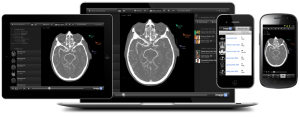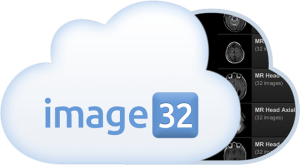The following is a sponsored post for image32. Beyond sponsoring 33c to start this conversation, the words, ideas and thinking below are mine alone.
It happens nearly every week in my clinic: A child arrives for consultation with an x-ray or CT scan on a disk. I try to open the images on my exam room computer and I can’t do it due to interoperability issues. Then there are two outcomes: My ability to assess is impaired or the child is exposed to repeated testing with added cost and radiation exposure.

image32, a start up out of Silicon Valley has a solution that puts me, my parents and other consultants on the same page. Or in this case the same screen.
It’s simple: Participating doctors or patients upload images into image32’s private cloud. PHI is scrubbed using i32’s proprietary software. The images can be shared (and simultaneously viewed) at the discretion of the treating doctor or patient. This allows doctors to share studies to obtain curbside consultations and expedite patient transfers, all without having to worry about unintentionally revealing identifying patient information.
There’s more to it than that but this product offers a simple but compelling solution to medicine’s endemic problem of silos.
Here’s why I see image32 carving a space in the digital age of medicine:
The future is patient-centered and controlled. They clearly see the future as centered on the patient. image32 takes images from the secure, iconic vault of the institutional server and into the hands of the patients and doctors who need them. In addition to falling in line with the general trend of decentralization and patient control, i32’s model pummels traditional barriers to communication and collaboration.
Beyond films. Images in medicine are not limited to radiographs, of course. Pictures of eye grounds, EKGs, rashes or anything else captured graphically represent potential fodder for a secure, private platform like image32.
Prepped for new models of patient care. As doctors continue to get pinched, new models of delivery and consultation are beginning to emerge. The proprietary technology behind image32 will be difficult to replicate on an individual level, applications like this will serve to connect the world.
Medical education beyond screen shots. Beyond patient care is how doctors learn patient care. And we learn by seeing. image32 is already serving as a space for de-identified images for education. What’s huge is that an MRI of the spine, for example, can be scrolled through sequentially as a living study with annotations made by a teaching neurosurgeon. When Sal Khan finally makes his move in medical education, a thoughtful source platform for images like i32 will likely fit the bill. I understand that image32 will soon be embeddable so that sites like Khan, journal sites, or even textbooks will be able to have a fully functional image viewer as an integral part of the site.
Silky smooth UI. User experience is king. image32 offers a silky smooth thoughtful interface that’s easy on the eyes and mind.
Images are central to the workflow of modern medicine. Patients are central to health care. image32 puts those images into the hands of the patient where they can curate and share on their own terms. Check it out.
